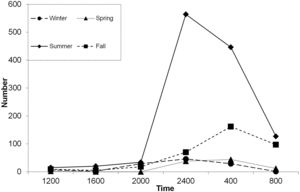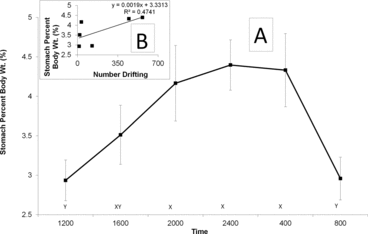Abstract
Downstream drift of aquatic invertebrates is an important ecological process that varies temporally. Seasonal patterns of diel drift and diel feeding periodicity during summer of the amphipod Gammarus pseudolimnaeus were examined in a small stream in central New York. Seasonal trends in drift were similar with peak drift occurring from 2000 to 0400 h. Very little drift occurred during the day. Feeding intensity of G. pseudolimnaeus was greatest from 2000 to 0400 h and was significantly greater than at 0400 to 0800 h and 0800 to 1200 h. Previous research on feeding periodicity of this species found no evidence of periods of increased food consumption. Conflicting results between this study and earlier studies may be due to sampling drifting versus non-drifting amphipods.
Introduction
One of the cornerstones of stream ecology is the downstream dispersal of aquatic invertebrates in the drift (Waters Citation1962, Citation1965; Wilzbach et al. Citation1988). The most commonly studied type of drift of aquatic invertebrates is behavioral and is associated with diel activity patterns (Waters Citation1965). Specifically, many species of aquatic invertebrates enter the drift during periods of low light intensity. This activity functions as a downstream population dispersal mechanism and, since it occurs during periods of low light, it may reduce predation (Wilzbach et al. Citation1988). Downstream dispersal of aquatic invertebrates in the drift is thought to be compensated by upstream movement (Müller Citation1974) as well as by in situ production rates (Waters Citation1981). Upstream movements generally occur along the stream margins (Elliott Citation2002) or by the upstream flight of adult insects (Wilzbach et al. Citation1988).
Amphipods, especially Gammarus, are known to comprise a large component of the invertebrate drift in streams where they occur (Iversen & Jensen Citation1977; Waters & Hokenstrom Citation1980). In lotic environments worldwide, Gammarus are considered to be important stream detritivores with similar behaviors (Lagrue et al., Citation2011). Virtually all studies of the drift of Gammarus in streams have found that peak numbers in the drift occur about 1 hour after sunset and just before dawn (Waters Citation1962; Elliott Citation2002). There have been conflicting findings in regard to the relationship between the densities of amphipods present and drift rates. Statzner et al. Citation(1984) found no relationship between densities and drift rate, whereas Williams and Moore (1989) reported a positive relationship. I examined the seasonal diel drift of Gammarus pseudolimnaeus in Beaver Brook, a small stream in central New York, USA. The amphipod represented the most abundant aquatic invertebrate in the stream. Also examined were diel trends in feeding periodicity during summer.
Methods
Beaver Brook is a small second-order stream of the Lake Ontario drainage located in the southwest corner of Cortland County, NY, USA. The brook is approximately 9.1 km long and drains an area of 2419 ha before entering Fall Creek, which eventually discharges into Cayuga Lake. Little seasonal variation in flow (mean 0.07 m3/s; range 0.06–0.09 m3/s) is observed within the study area. Stream width averages 3.5 m with an average depth of 10 cm. Substrate consists of a mix of gravel and cobble with areas of low flow trapping organic material.
Three drift nets (aperture 91.4 × 61 × 30.5 cm, mesh size 0.60 mm) were set longitudinally along a transect of Beaver Brook over one 24-h period during each season. Nets were set in the same riffle habitat during each season in the center of the stream. The nets were set in parallel about 0.25 m apart. Every 4 h (0400, 0800, 1200, 1600, 2000, and 2400 h) over a 24-h period, nets were emptied and reset during the winter (March), spring (May), summer (August), and fall (October) 2009. Drift samples were combined and immediately preserved in 80% ethanol.
In the laboratory, amphipods were sorted and identified to species and enumerated. Specimens of G. pseudolimnaeus used to estimate feeding periodicity were weighed (wet weight, nearest 0.0001 g) prior to having the digestive tract removed and weighed (nearest 0.0001 g). The ratio of the wet weight of the entire digestive tract to the body weight of each amphipod was used as the index of feeding periodicity. To avoid disproportionate influence by individual amphipods, mean values at each 4-h interval were used as the index of feeding periodicity. Feeding periodicity was only estimated during summer, when G. pseudolimnaeus were most abundant in the drift and consisted of a minimum of 25 individuals collected at each 4-h interval. Linear regression was used to examine the relationship between the number of G. pseudolimnaeus drifting to feeding intensity during the summer.
Because the data were not normally distributed, differences in the number of amphipods captured in the 24-h drift among seasons and feeding intensity at each 4-h interval were compared using a Kruskal–Wallis one-way analysis of variance followed by a Tukey's multiple comparison test to identify significant homogenous groups using StatistixTM 8.0 Analytical Software (http://www.statistix.com/). Independent paired t-tests were used to determine significantly different groups over the 24-h period to evaluate differences in feeding periodicity. A significance of α = 0.05 was used for all statistical analyses.
Results and discussion
Diel patterns of drift of G. pseudolimnaeus were consistent among seasons, peaking at night (. Peak drift rates occurred from 1600 to 0400 h. Very little drift by G. pseudolimnaeus occurred during the day. During all four seasons, drift rates of G. pseudolimnaeus were consistent from 0800 to 2000 h. The drift rate of G. pseudolimnaeus at 2400 and 0400 h during summer far exceeded those during any other season. However, overall there was no significant difference in drift rates among seasons.
Figure 1. Numbers of G. pseudolimnaeus collected in the drift during winter, spring, summer, and fall at 4-h intervals over a 24-h period in Beaver Brook, Cortland County, NY, USA.

The ratio of stomach weight to body weight of G. pseudolimnaeus was lowest from 0400 to 1200 h ((A)). After 1200 h, food consumption increased, and was highest from 1600 to 0400 h. The ratio of stomach weight to body weight at the 1600 to 2000 h, 2000 to 2400 h, and 2400 to 0400 h time intervals was significantly greater than at the 0400 to 0800 h and 0800 to 1200 h time intervals. There was a positive correlation between the overall number of G. pseudolimnaeus drifting and the feeding intensity (p < 0.05, R2 = 0.47, (B)).
Figure 2. Diel feeding intensity of G. pseudolimnaeus in Beaver Brook, Cortland County, NY, USA, (A) over a 24-h period during summer and (B) regression between the feeding intensity of G. pseudolimnaeus and the number of the species collected in the drift. Standard error bars are given at each interval. Different letters along the X-axis (X, O) represent significant differences in feeding intensity between 4-h intervals.

Similar to the seasonal drift of G. pseudolimnaeus in Beaver Brook, Waters Citation(1962) found that the abundance of this species in the drift was also highest during summer in a Minnesota stream. However, whereas the patterns of diel drift activity of G. pseudolimnaeus in Beaver Brook were consistent among seasons, they were less consistent among seasons in the Minnesota study. Peak drift of Gammarus has been reported to occur soon after sunset (Waters Citation1962; Elliott 2002). Drift rates generally decline during the night (Waters Citation1962) but may also peak just before sunrise (Elliott 2002). In Beaver Brook, the drift rate of G. pseudolimnaeus increased after 2000 h, peaking at 2400 h, and generally declined until 1600 h during all seasons.
Marchant and Hynes Citation(1981) found that G. pseudolimnaeus fed continuously over a 24-h period and exhibited no evidence of diel variation in feeding periodicity in the Credit River in Ontario. This contrasts sharply with the findings in this study where G. pseudolimnaeus exhibited feeding peaks from 2000 to 0400 h in Beaver Brook. Seasonal differences in diel feeding activity between the studies are not an issue since both were done during August and neither was the size of amphipods examined (i.e., both studies used 4–8 mm specimens). A more likely result of the difference in findings between the studies was how amphipods were collected. The study done in the Credit River collected G. pseudolimnaeus every 4 h over a 24-h period with a hand net. G. pseudolimnaeus in Beaver Brook were collected in drift nets. Consequently, it is likely that the majority of amphipods collected in the earlier study were not drifting compared to those in Beaver Brook.
In Beaver Brook, feeding activity of G. pseudolimnaeus peaked from 2000 to 0400 h, when the drift of G. pseudolimnaeus was highest. However, feeding activity actually increased after 1200 h when the drift of amphipods was low. The data from Beaver Brook suggest peak feeding of G. pseudolimnaeus that is associated with peak drift rates. This potential link between feeding activity and drift of G. pseudolimnaeus has not previously been reported and appears to conflict with previous research. However, the apparent conflict when comparing these findings to previous work may be the result of sampling non-drifting versus drifting amphipods. Further research is needed to clarify diel feeding patterns of drifting versus non-drifting amphipods.
Acknowledgements
I thank the students from the Environmental Careers class at Tunison Lab and Tim Wallbridge and Chris Nack for their participation in the field and in the laboratory. This article is contribution 1817 of the USGS Great Lakes Science Center. Any use of trade, product, or firm names is for descriptive purposes only and does not imply endorsement by the U.S. Government.
References
- Elliott JM. 2002. A continuous study of the total drift of freshwater shrimps, Gammarus pulex, in a small stony stream in the English Lake District. Freshwater Biol. 47:75–86.
- Lagrue C, Kaldonski N, Montreuil S, Lafèvre T, Blatter O, Giraud P, Bollache L. 2011. Interspecific differences in drift behavior between the native Gammarus pulex and the exotic Gammarus roesel: and possible implications for the invaders success. Biol Invasions. 13:1409–1421.
- Marchant R, Hynes HBN. 1981. Field estimates of feeding rate for Gammarus pseudolimnaeus (Crustacea: Amphipoda) in the Credit River, Ontario. Freshwater Biol. 11:27–36.
- Müller K. 1974. Stream drift as a chronobiological phenomenon in running water ecosystems. Annu Rev Ecol Syst. 5:309–323.
- Statzner B, DeJoux C, Elouard JM. 1984. Field experiments on the relationship between drift and benthic densities of aquatic insects in tropical streams (Ivory Coast). I. Introduction: review of drift literature, methods, and experimental conditions. Rev Hydrobiol Trop. 17:319–334.
- Waters TF. 1962. Diurnal periodicity in the drift of stream bottom organisms. Ecology. 43:316–320.
- Waters TF. 1965. Interpretation of invertebrate drift in streams. Ecology. 46:327–334.
- Waters TF. 1981. Seasonal patterns in production and drift of Gammarus pseudolimnaeus in Valley Creek, Minnesota. Ecology. 62:1458–1466.
- Waters TF, Hokenstrom JC. 1980. Annual production and drift of the stream amphipod, Gammarus pseudolimnaeus, in Valley Creek, Minnesota. Limnol Oceanogr. 25:700–710.
- Williams DD, Moore KA. 1989. Environmental complexity and the drifting behavior of a running water amphipod. Can J Fish Aquatic Sci. 46:1520–1530.
- Wilzbach MA, Cummins KW, Knapp RA. 1988. Toward a functional classification of stream invertebrate drift. Verh Internat Verein Limnol. 23:1244–1254.
